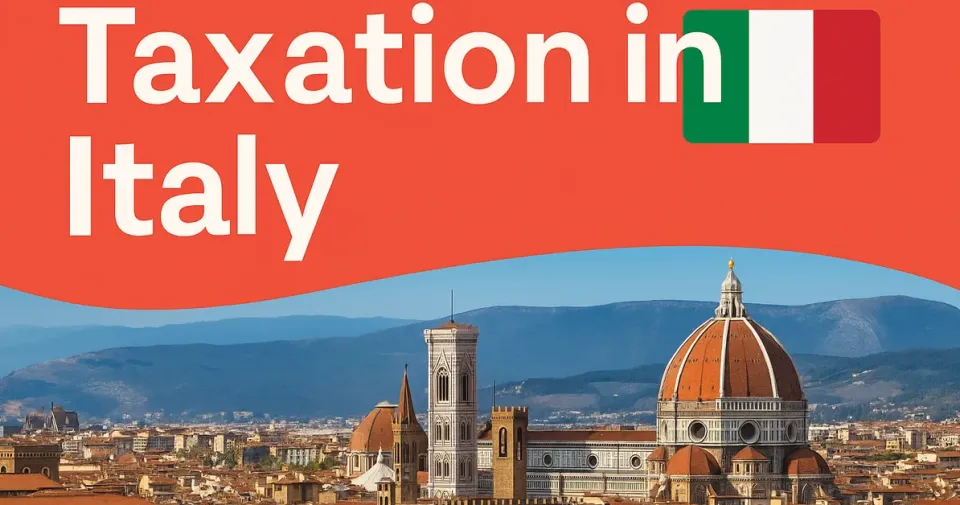Taxation in Italy

Taxation in Italy combines progressive personal income tax, moderate corporate rates, and a layered system of regional and municipal surcharges. For expats, entrepreneurs, and globally mobile families, Italy now pairs its lifestyle advantages with targeted tax regimes that can materially reduce the overall burden. This guide walks through the essentials—who pays, how much, and which incentives can change the outcome—so you can plan with clarity before you relocate, invest, or hire.
Overview of the Italian tax system
Taxation in Italy is residence-based for individuals: residents are taxed on worldwide income; non-residents are taxed only on Italian-source income (e.g., Italian employment, rentals, or business profits). For companies, corporate income tax applies to profits, with additional regional levies tied to productive activity. Value-added tax (IVA) is charged on most goods and services, while property, inheritance, and stamp duties round out the framework.
Italy’s system is sometimes perceived as complex; however, the core building blocks are stable and predictable: IRPEF (personal income tax), IRES (corporate income tax), IRAP (regional tax on productive activities), and IVA (VAT). Municipalities can also set add-ons to personal tax within regulated ranges. For newcomers, the key to efficiency is understanding how these layers interact and which special regimes apply to your profile.
Double taxation relief is available through Italy’s broad treaty network. These treaties coordinate which country taxes which income category and allow credits to avoid paying twice on the same euro—a crucial point for Americans, Canadians, and other expats with cross-border income.
Personal income tax (IRPEF)
Residents pay IRPEF on worldwide income using progressive brackets. Non-residents are generally taxed at flat or specific rates on Italian-source income (employment performed in Italy, Italian rentals, pensions originating in Italy, etc.). Employment income is typically withheld at source by the employer; the annual return reconciles allowances, credits, and deductions.
| IRPEF bracket (annual taxable income) | Rate | Notes |
| Up to €28,000 | 23% | Entry band after simplification of brackets |
| €28,001 – €50,000 | 35% | Mid band for middle-income earners |
| Over €50,000 | 43% | Top statutory rate |
On top of IRPEF, regional and municipal surcharges apply:
- Regional surtax (Addizionale Regionale): commonly ~1.2%–2.03% depending on region.
- Municipal surtax (Addizionale Comunale): up to ~0.8% depending on municipality.
Social contributions are separate from IRPEF. Employees and employers both contribute; exact rates vary by contract type and sector. Self-employed professionals pay their own pension and welfare contributions on declared income.
Corporate taxation (IRES & IRAP)
Companies resident in Italy are taxed on worldwide income; non-residents are taxed on Italian-source income. Two main taxes apply:
| Tax | Standard rate | Applies to |
| IRES (corporate income tax) | 24% | Net corporate profits |
| IRAP (regional tax on productive activities) | 3.9% baseline | Value added generated in the region |
Local incentives, accelerated depreciation, and R&D credits may reduce the effective rate for qualifying investments. Italy has also modernized rules on interest deductibility, loss carryforwards, and anti-avoidance. Group relief and tax consolidation are available subject to conditions.
VAT (IVA) and indirect taxes
Italy applies VAT on supplies of goods and services, intra-EU acquisitions, and imports. Businesses must charge VAT, file returns, and comply with e-invoicing rules. Exporters can request refunds or special regimes to manage cash flow.
| IVA rate | Percentage | Typical examples |
| Standard | 22% | Most goods and services |
| Reduced | 10% | Certain food, hospitality |
| Super-reduced | 4% | Essentials, books |
Other indirect taxes include excise duties on fuels, alcohol, and tobacco; registration and stamp duties for legal acts; and motor vehicle taxes aligned with engine capacity and emissions.
Property, inheritance, and wealth-related taxes
Italy does not have a general annual wealth tax on domestic assets, but specific levies apply to property and foreign holdings:
- IMU: applied to second homes; rates often 0.4%–1.06% of cadastral value.
- TASI/TARI: local charges for services, waste collection, municipal services.
- Purchase costs: registration, mortgage, and cadastral taxes or VAT on new builds, with first-home reliefs available.
Inheritance and gift tax:
| Relationship | Rate | Allowance |
| Spouse & descendants | 4% | €1,000,000 each |
| Siblings | 6% | €100,000 each |
| Other relatives | 6% | No allowance |
| Unrelated | 8% | No allowance |
Foreign assets trigger IVIE (0.76% on property abroad) and IVAFE (0.2% on foreign financial assets). Reporting via the “RW” form is mandatory.
Special regimes for expats and investors
- New resident flat tax (€100,000): fixed levy on foreign income for up to 15 years.
- Impatriate regime: 50–70% exemption on Italian income for newcomers.
- Pensioners’ 7% regime: flat tax on foreign income for retirees in Southern Italy.
- Researchers & professors: long-term exemptions on academic income.
Compliance and reporting
Newcomers should obtain a codice fiscale. Employees often have tax withheld at source, but annual returns allow deductions. Self-employed persons make advance payments. Italy has e-invoicing and strict record-keeping. Coordination with home-country rules (IRS, CRA, etc.) is essential for expats.
Current headline rates at a glance
| Tax | Rate | Notes |
| IRPEF | 23% / 35% / 43% | Regional & municipal add-ons apply |
| IRES | 24% | Corporate profits |
| IRAP | 3.9% | Regional activity tax |
| IVA | 22% / 10% / 4% | Standard and reduced rates |
| IMU | 0.4%–1.06% | Municipal property tax |
| Inheritance/gift | 4%–8% | With allowances |
| IVIE / IVAFE | 0.76% / 0.2% | Foreign real estate / financial assets |
Where to verify and learn more
Related content: Moving to Italy